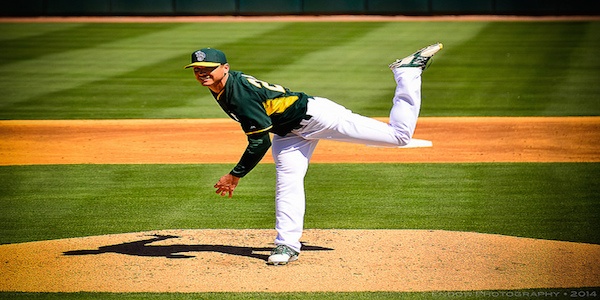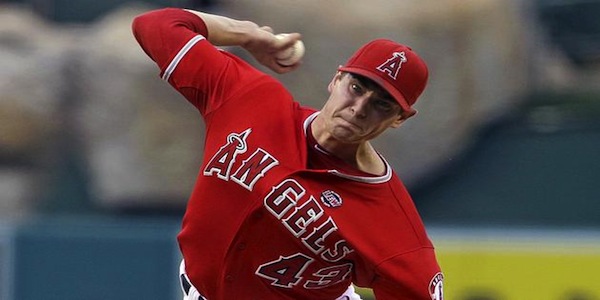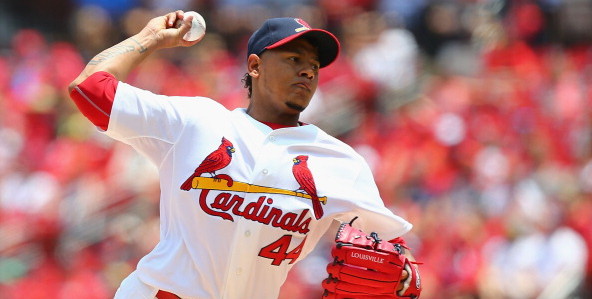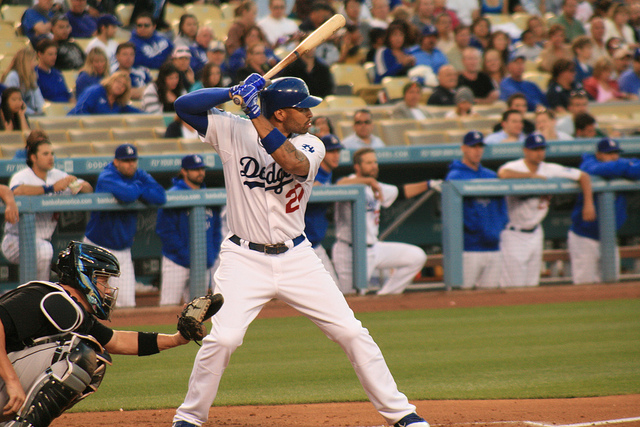2014 Fantasy Baseball: The “A” in Athletics Is for Aces

The Athletics have gotten exceptional pitching from their starting rotation, and three of their starters rank in the top 20 in ERA among qualified starters. Sonny Gray leads the pack ranking ninth, Scott Kazmir ranking 12th, and Jesse Chavez rounding out the trio ranking 17th. The important thing at this point is determining which of these pitchers looks like they can sustain much of their early season success. The short answer is that the underlying numbers indicate all should continue to pitch well, but how is each of them going about pitching so well?
Let’s start by looking at Chavez since he ranks lowest among the three in ERA. Colleague Ryan Noonan wrote about the well traveled right-hander earlier in the month, and you should read that article. Now that we have a few more starts of his in the books, though, I’d like to take my own look at him. Chavez spent most of the beginning of his career working as a reliever after he struggled in the low minors as a 19 and 20 year old as a member of the Rangers organization back in 2003 and 2004. He wouldn’t make another start until 2007, and that start was part of a 46 appearance season in Triple-A with the Pirates organization. His transition back to starting began with the Blue Jays as a 28-year old in 2012, so it’s understandable that the baseball community is having a hard time wrapping their head’s around his breakout this season as a 30-year old.
It’s likely that if not for injuries to Jarrod Parker and A.J. Griffin, this breakout wouldn’t be happening at all. Regardless of the circumstances, Chavez has settled in and proven more than deserving of his rotation spot. Chavez’s FIP of 3.07 is a nice indicator that his 2.44 ERA isn’t all that crazy. He’s limiting walks (5.8% BB%), and he’s striking hitters out at a healthy clip (24.6% K%). There is some luck at play since he’s unlikely to maintain a .254 BABIP the rest of the year, but his left-on-base percentage and home run rate aren’t exceptionally lucky. Chavez has had problems stranding runners at times in the past, and his 78.3 percent left-on-base percentage is better than what FanGraphs has as the league average (72.8 percent), so some give back isn’t out of the question. Overall, I like Chavez, but don’t expect him to maintain his strikeout pace.
Chavez’s swinging strike percentage is 8.9 percent, just below the league average of 9.3 percent. These days he’s leaning heavily on his sinker and cutter, and he’s rarely throwing the fourseam fastball he primarily used out of the bullpen in past seasons. He backs his fastball mix with a curveball and changeup, and his repertoire gives him the goodies to get both lefties and righties out. The problem for him maintaining his strikeout rate is that none of his pitches stand out as an above average bat misser. I set the minimum pitches thrown to 100 on Baseball Prospectus’s PITCHf/x leaderboard, and his sinker, cutter, changeup, and curveball all ranked in the bottom half in whiff/swing percentage. Chavez can still be outstanding even with a reduced strikeout rate, but those owning him should probably bank on something closer to the league average of 20.5 percent in strikeouts than his present rate for the rest of the year.
The second best qualified ERA in the A’s rotation belongs to Kazmir. Last year he made a remarkable return from the abyss, or independent league baseball if you prefer, and the A’s were sold and ponied up for two years of his services. The once effectively wild-but-electric starter hasn’t lost much of his stuff and is now painting. Kazmir’s 4.4 percent walk rate ranks tied with Jordan Zimmermann for the 10th best among qualified starting pitchers. Don’t be fooled, though, he’s not some kind of pitch to contact starter. His 20.7 percent strikeout rate is a little better than what FanGraphs has as the league average (20.5 percent), and I’m inclined to believe there are more strikeouts on the horizon.
Of the 106 qualified starting pitchers, Kazmir is tied with four others for the 28th best whiff percentage. The southpaw is throwing a deep mix of pitches at opposing batters that includes a fourseam fastball, sinker, cutter, changeup, curveball and slider. A handful of those pitches are solid bat missers. Among 127 starters that have thrown 100 fourseam fastballs, Kazmir ranks 36th in whiff/swing percentage according to the PITCHf/x leaderboard at Baseball Prospectus. While it’s nice that his fourseam fastball can get some empty swings, using the same 100 pitch criteria reveals that his changeup is filthy. Kazmir’s changeup ranks 16th out of 47 in whiff/swing percentage and dropping the threshold to 50 pitches allows Kazmir’s slider, he’s thrown 84, to qualify. The slider ranks 12th out of 87 in whiff/swing percentage.
It’s not all about the strikeouts with Kazmir either. When batters are making contact with his offerings they’re pounding it into the ground more than half the time. FanGraphs has the 30-year old starter’s groundball rate at 51.4 percent, and considering he has cut his fourseam fastball usage from last year in half while bumping up his sinker and cutter usage, it’s not surprising he’s made such a significant gain in inducing worm burners. His combination of a low walk rate, strong (and likely improving) strikeout rate, and high groundball rate is tantalizing. Furthermore, Kazmir has eradicated the nasty platoon split he demonstrated in 2013. The southpaw has faced 157 right-handed batters this year and they’ve hit a paltry .191/.242/.279 against him.
The biggest concern with Kazmir is how he’ll hold up over the course of a full season. The reason for that concern is simple, he had a huge innings leap last year. In 2012 he threw just 64 innings before seeing that jump to 163 innings last year (and that doesn’t include winter ball or spring training). Concerns of him wearing down are fair, but I wouldn’t move him in a deal unless I was overwhelmed. In fact, now makes for a nice buy high time with Kazmir. He’s pitching well, and uninformed gamers might be alarmed by his perceived down velocity in May. Thanks to a bit of info Eno Sarris passed along from an interview with Dan Straily, it has come to my attention the guns are cold in Oakland. Take a look at this info available at Brooks Baseball. Guns in Oakland are robbing pitchers of over 1.4 mph. Those that are out of the know will think something is wrong with Kazmir this month, but the savvy gamers will see he’s made two starts at home and that alone explains his “down” velocity.
The last of the A’s trio of aces, or at least pitchers that have pitched like aces this year, is Gray. He’s certainly not falling prey to a sophomore slump, and he earned American League Pitcher of the month honors for the month of April. The best thing the young right-hander is doing is keeping the ball on the ground at a really high rate. Among qualified starters he ranks 12th in groundball rate with a rate of 55.1 percent. Beyond that, the rest of his numbers are more good than great despite what his sterling ERA would suggest.
Gray’s strikeout rate of 19.5 percent is one percent below the league average and his walk rate of 8.1 percent is almost exactly in line with it. Interestingly, his zone percentage is exactly league average, and his first pitch strike percentage is 1.5 percent below it, so his walk rate is probably not going to change a great deal. Also, with a swinging strike percentage of 7.9 percent, it’s not likely he’ll see an uptick in strikeouts, unless of course something changes.
I add the caveat about something changing because in Gray’s case, it is possible. Gray has nearly doubled his changeup usage this year. It’s his worst offering, behind his fourseam fastball, sinker, and curveball, and he’s not currently coaxing many empty swings with it. Because Brooks Baseball only credits him with throwing 135 changeups, I’ve set the Baseball Prospectus PITCHf/x leaderboard minimum number of pitches thrown to 100. A total of 47 pitchers have thrown 100 or more changeups this year, and Gray’s changeup ranks 39th in whiff/swing percentage. Like I said, he’s not missing many bats with it. That doesn’t mean the pitch is a total dud, though, when sorting the same leaderboard by groundball-by-balls in play, Gray leads pitchers in that category by a wide margin (84 percent and the next closest pitchers are Jake Peavy and Henderson Alvarez at 73 percent).
Gray is a really good starter. A combination of a league average strikeout and walk rate with a sky high groundball rate will continue to treat the second year hurler well, but probably not this well. I was bullish on Gray coming into the year, and I still like him, but his owners should try and shop him to pitching needy owners as his value is unlikely to be higher than it is now. For the rest of the year I expect Kazmir to be the best fantasy arm of the bunch, followed by Gray and then Chavez, and all three will help owners in leagues of all sizes.





